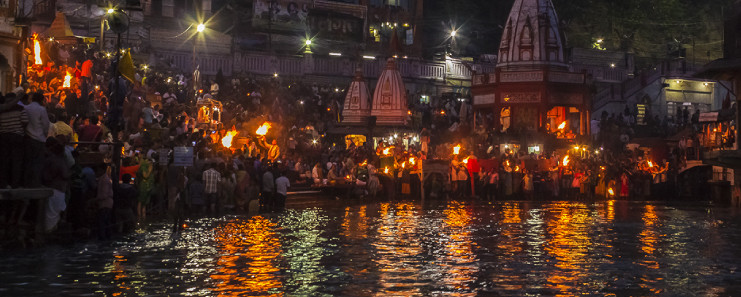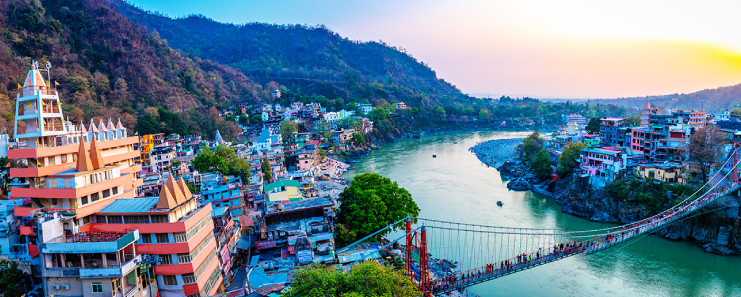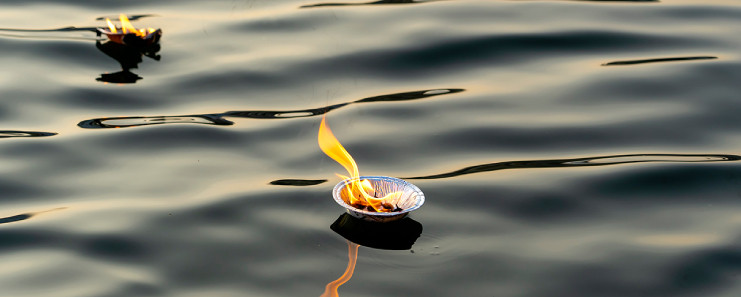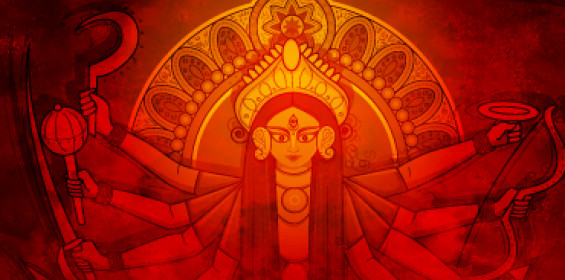For over two millennia, the Ganga has been revered as a symbol of spiritual purity. As climate change and callous industrialization holds an unforgiving mirror to our deeds, let us instead look at the past. This Ganga Saptami, celebrated each year on April 30, let us go down the fascinating history of this much-revered river. Our illustrious past could inspire similar deeds in the future.
500 years after Alexander’s visit to India, in 200 CE, the Piazza Navona fountain was erected in Rome. The sculpture of this fountain showcased four important rivers of the world. Three of the sculptures included the rivers one can expect the Romans to have known:
- Tiber that flowed through Rome
- Rhine that flowed on the northern side of the Alps, through Germany which was part of the Roman empire
- Nile that flowed through Egypt with which Rome had close ties
The fourth river was far away from Rome, continents away. It was the Ganga, located in India, epitomising the greatness of a land that had captured the imagination of people around the world. A land that came to be known by the name of a river. A river that influenced Greek, Roman and European thought 1,800 years ago in 200 CE.

The river Ganga has been deified, worshipped, venerated. So famed has been her illustrious glory that over 5,000 years ago, Lord Krishna declared in the Bhagavad Gita: “I am the wind among things of purification, and among warriors, I am Rama, the hero supreme. Of all the fishes in the sea, I am Makara, the wonderful, and among all rivers, the laudable Jahnavi.” (Chapter 10, verse 31). Jahnavi is another name for Ganga.
It is believed that Jahnavi was brought down from the heavens, and the day she was re-born is celebrated as Ganga Saptami. Falling on April 30, Ganga Saptami is also called Ganga Jayanti. Reborn, you ask? Well, as all good things, there is a story. In fact, many. To fully appreciate the significance of Ganga Saptami, these stories assume more importance.
Right from ancient yore
From the days of Strabo in 25 CE to Ptolemy in 140 CE and Peutinger in 200 CE have included the flowing Ganga in their maps. It was a distinguishing feature of India.
The origin of Ganga
According to Hindu legends, Ganga descended on earth on a day called Ganga Dussehra. There was a fear that the mighty Ganga could sweep the entire earth away. To break her flow and fierce descent, Lord Shiva took Ganga in his hair, releasing her later. It is believed that Ganga’s aim was to purge the cursed souls of King Bhagiratha’s ancestors. As she flowed towards the kingdom of Bhagiratha, her flow destroyed the ashram of sage Jahnu. This angered him greatly and in a temper, he drank all of Ganga’s waters.

The gods and King Bhagiratha were greatly alarmed at these happenings, and prayed to the sage. Appeased, sage Jahnu released Ganga from his ear on the saptami of the Vaishakha Shukla Paksha. Thus Ganga is also known as Jahnavi, the daughter of sage Jahnu, and the day is celebrated as Jahnu Saptami.
Another story from the Puranas suggests that Ganga emerged from Lord Vishnu’s toe to bless the 60,000 sons of King Sagar who were cursed by sage Kapil. They had turned into ashes and King Bhagiratha had brought Ganga on earth. Thus, the river is also called Bhagirathi.
The South East Asian river, Me Kong, refers to the Cambodian equivalent of, Ma Ganga. Detailed sculptures along the river depict its legend, including her flow from Lord Vishnu’s feet to the upper and lower reaches of the hills. The sculptures also show the river moving over a large Shiva linga and 1,000 smaller Shiva lingas.
Ma Ganga and Me Kong empty into the Bay of Bengal which was called Ganga Sagar for many millennia. In South India, it was called Vanga Kadal (kadal referring to the sea). It was only after the British that maps of India started calling the area, the Bay of Bengal. Ganga Sagar was soon forgotten.Ganga: a spectacular engineering feat
There is a fascinating and little known story about the association of King Bhagiratha and Ganga. Indeed, he brought her down but not how it is conventionally believed.
Bharath Gyan, a passionate research initiative, is painstakingly dotting the pieces together, foraging amongst lost remnants to keep the glorious past alive and known. This was what they uncovered:
When we understand our past, we are prepared for the future. Tap into timeless wisdom from the ancients, and get ready for the future. You will be surprised at how relevant and timely these secrets are. Find out more at The Art of Living Meditation and Breath workshop.
Tap into timeless wisdom from our ancients. Learn the secrets of the mind & breath>>

The engineering project has been examined through different lenses: the famous Ganga legend, the British surveyors who studied the sources of the Himalayan rivers over a century ago as well as the current geological facts.
The river course has also been looked at from three stages:
- Tibet to Bindu Sarovar
- Bindu Sarovar to Haridwar
- Haridwar to Rajmahal Hills and thereon to the sea.
King Bhagirathi bringing Ganga down to earth is considered to be a great feat - a massive river engineering one. Legends and texts such as the Gangavataran considered it to be the cumulative effort of five generations, beginning from King Sagara, his sons - the 60,000 Sagaraputra, their successors - Anshuman, Dilipa and Bhagiratha.
1. King Sagara: King Sagara undertook tapasya at Bhrigu Ashram, close to Gaumukh and identified the Gangotri glacier as a potential source of water for his kingdom. He also understood that opening up the water source was only one step. The water could flow anywhere downstream.
2. His sons: The 60,000 Sagaraputra, followed up his effort by digging the canal using the implements of their time right through their land, in the plains, all the way upto the sea at present day Rajmahal Hills area in Jharkhand state. The area shows remnants of volcanic activity. According to legend, the 60,000 Sagaraputras met sage Kapila and were burnt to ashes by his gaze. Did the Sagaraputras meet their end in a volcano?
3. Their successor Anshuman surveyed the upper reaches of Himalayas as well as the Rajmahal hills.
4. His son Dilipa, spent a large part of his life in the Shivalik ranges, where the pathway for Ganga had to be created to reach the plains.
5. Once the course for the river had been created from the Bindu Sarovar to the seas at Rajmahal, it was king Bhagiratha who broke open the gorge and released Ganga into the channel. It led her down the Shivalik range, down the canal dug by the Sagaraputras and into the sea.
Reflecting the true significance of Ganga Saptami
“The Ganges is above all the river of India, which has held India’s heart captive and drawn uncounted millions to her banks since the dawn of history.”
- Jawaharlal Nehru, India’s first prime minister
Originating in the Himalayas, Ganga travels 1,600 miles across plains before merging into the Bay of Bengal. Almost 1/10th of the world’s population is estimated to live on her banks.
Referring to the Ganga, Lord Vishnu in the Ramayana proclaimed: “Man becomes pure by the touch of the water, or by consuming it, or by expressing its name.”

This might become a distant memory if we don’t act fast. “While the legend of Ganga showcases the capabilities and knowledge of our ancients, it is also a call to all Indians to think about Ganga in the light of reports that the Gangotri glacier is fast disappearing and Ganga will cease to be a perennial river in the next 100 years,” says Dr. D.K. Hari, founder of Bharath Gyan. He adds, “History shows us that even the mightiest of the rivers can go dry due to glaciers vanishing or due to natural calamities”
Nature seems to be experiencing a rebirth, amidst the coronavirus shutdown. The Ganga river, too, has shown some promising changes.
* Lower pollution levels and industrial effluents owing to the shut-down of factories and daily civil activities.
* An increase in dissolved oxygen levels in April 2020 when compared to the previous month.
* Re-emergence of aquatic life in some places like Varanasi.
Environmentalists mourn at the lack of apathy and drive in all sectors of society. For all our strides in nuclear technology, outer space and even the microbial world, our work to clean, and maintain a sacred river is woefully little. Yet, the clock has not stopped ticking. Perhaps the true significance of Ganga Saptami lies in this meaning.
The material has been sourced from @bharathgyan. This research team, led by a passionate husband-wife duo - Dr. DK Hari and Dr. Hema Hari, unearth some of India’s untold stories and make them contemporary. You can click here to buy any of their books on Indian civilization.































